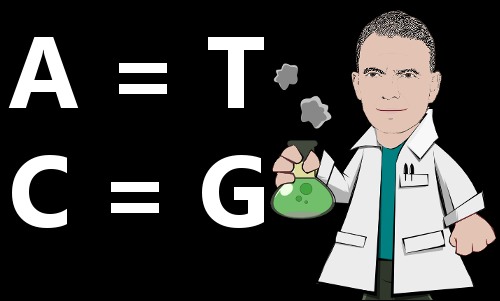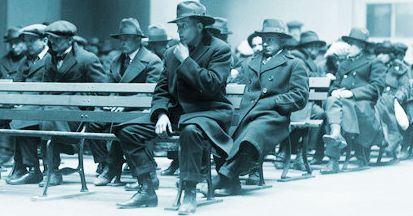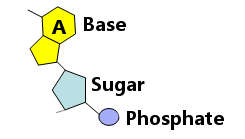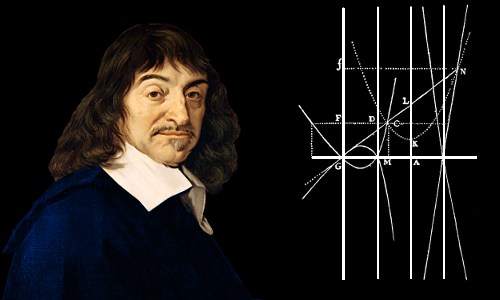Erwin Chargaff

Lived 1905 – 2002.
Erwin Chargaff’s research paved the way for the discoveries of DNA’s structure and its method of replication. His observation that DNA varies from species to species made it highly credible that DNA was genetic material.
His identification of 1:1 ratios in DNA’s bases allowed James Watson and Francis Crick to see how these bases slotted into the double helix and how DNA could act as a template for copies of itself.
Advertisements
Beginnings
Erwin Chargaff was born into a wealthy family on August 11, 1905, in the city of Czernowitz, one of the provincial capitals of Austria-Hungary. The city is now in Ukraine.Erwin’s father was Hermann Chargaff, who owned a small, private bank. His mother was Rosa Silberstein. Both of his parents were well-educated, German-speaking, Austrian Jews. They had two children: Erwin and his younger sister Greta.
Erwin enjoyed a comfortable childhood, although he worried his parents by taking a long time to learn to speak. The family home was furnished with a small library, whose books were a source of constant fascination and inspiration for Erwin as he grew up.
When Erwin was five, his father’s bank ran into financial difficulties – money had been embezzled by employees – and his father had to look for a job.
World War 1 began in July 1914. The Chargaffs were vacationing at a Baltic Sea resort when reports came to them that the Russian Army was about to capture Czernowitz. Abandoning any hope of returning home, they made other plans.
Vienna, School and Culture
They headed for Vienna, Austria’s capital city. Erwin arrived in Vienna on about his ninth birthday and came to regard it as his home town.He was educated at one of Vienna’s best schools – the Maximiliansgymnasium – and loved it. He was taught Greek and Latin, excelling in both languages. Ironically, for someone who took such a long time to speak his first words, he turned out to be extraordinarily gifted at learning new languages: he would eventually master fifteen.
The school did not teach much physics and there was no chemistry at all. Science was mostly restricted to natural history. Away from school Erwin joined the Boy Scouts and continued to read avidly – getting through most of Western classical literature.
 “My real reading began, I believe, in 1920, when my mother gave me as a present Goethe’s complete works in the sixteen volumes of the beautiful Insel edition. They still stand, much read on my shelves.”
“My real reading began, I believe, in 1920, when my mother gave me as a present Goethe’s complete works in the sixteen volumes of the beautiful Insel edition. They still stand, much read on my shelves.”
Erwin Chargaff
Heraclitean Fire, 1975
University
Reveling in all things intellectual, Erwin Chargaff was clearly destined for academia. At the age of 18, however, he was still unsure about what he should study. He did not think he would make a good physician; he hated the idea of becoming a teacher; law was good only for doing business and he found commerce unattractive.In the end he chose chemistry, because he knew nothing about it. Moreover, a rich uncle owned alcohol factories where he might be employed one day as a chemist if he needed a job.
Chargaff spent five years studying at the University of Vienna. In the summer of 1928, aged 23, he graduated with a Ph.D. in chemistry.
Overall, he said he disliked chemistry much less than he had expected to. His thesis was about organic silver complexes and the reaction of iodine with azides.
While studying for his doctorate, Chargaff enquired about papers published in the Journal of the American Chemical Society, but he was told not to bother – nobody ever published anything useful in it!
The 1920s were unstable times in Austria. Inflation was rampant, reaching 2,500 percent in 1922. In 1927 there were serious riots in Vienna. Meanwhile, the universities were producing far more graduates than there were jobs.
Arrested in America
The path of least resistance seemed to be to continue with chemistry, but not in Austria.Chargaff made a successful application for the Milton Campbell Research Fellowship in Organic Chemistry. Despite earlier being told that no useful chemistry was done in America, he was soon sailing for New York. Arriving in the fall of 1928, rather than receiving a warm welcome, he was held pending deportation.

People awaiting deportation from Ellis Island in the 1920s.
After spending a few uncomfortable days on Ellis Island, Chargaff was rescued by Treat Johnson, Professor of Chemistry at Yale University.
Yale
Between 1928 and 1930, Chargaff worked successfully with Yale’s Rudolph Anderson, publishing seven papers, discovering two branched-chain fatty acids, and studying the tuberculosis bacterium.Unfortunately, he and his Austrian wife grew homesick – life in America was depressing. They returned to Europe in the summer of 1930.
Berlin
Chargaff spent two and a half years in Berlin, carrying out independent research at the University of Berlin’s Institute of Hygiene. He was exceptionally happy during this period, although he noted that Berlin was a city of tremendous contrasts – cultural splendor parading itself uneasily in a city troubled by financial turmoil and political unrest.In January 1933, the 27-year-old Chargaff saw Adolf Hitler become Chancellor of Germany. Chargaff saw a bleak future for Germany and for Jews in Germany.
In March 1933, he received a letter inviting him to work at the Pasteur Institute in Paris. Within a month, he and his wife had moved to Paris. There he worked on bacterial pigments and polysaccharides.
Soon Chargaff noticed that foreigners, who were arriving in Paris in large numbers from various parts of Europe, were being referred to as métèque – an unfriendly word referring to people of southern European origin. Chargaff decided the time had come to move yet again.
America Again – Columbia and Blood
And so, to his astonishment, Chargaff and his wife returned to America, the dispiriting country they were so glad to leave four years earlier.In 1935, Chargaff began working as a biochemist at New York’s Columbia University, becoming an assistant professor in 1938. Between 1936 and 1948 he studied blood coagulation.
Dropping Everything for DNA
In 1944, Chargaff became aware of research carried out by Oswald Avery and his colleagues at New York’s Rockefeller Institute. The Avery–MacLeod–McCarty experiment suggested that genes – the heredity code passed from parents to offspring – were made of DNA.Although Avery’s work was greeted by most scientists with skepticism, Chargaff was one of the very few to immediately embrace it. He decided to wrap up everything he had been working on and switch his lab’s focus to DNA.
Chargaff had also been influenced by the great quantum physicist Erwin Schrödinger’s 1944 book What is Life? Schrödinger proposed that the gene was a hereditary code-script.
Chargaff was not the only scientist captivated by What is Life? Other devotees included James Watson and Francis Crick. In 1944, Watson was 16 years old and studying biology at the University of Chicago; Crick was 28 years old and carrying out research for the British Royal Navy after abandoning his physics Ph.D. at the outbreak of World War 2.
Chargaff’s Rules
Chargaff believed Avery’s experiment indicated that living species differed because of differences in their DNA. Now he sought evidence in support of this belief.Working with a number of colleagues, including Ernst Vischer and Charlotte Green, Chargaff began getting interesting results in 1947. Chargaff prepared the DNA, while Vischer and Green used partition chromatography to separate it into its components for analysis by ultraviolet spectrophotometry. Although their early results were rather rough, Chargaff was reassured: they seemed to suggest there were real differences in DNA taken from different species.
At this stage Chargaff pictured a DNA molecule as a Moebius strip which could split along its center line with each of the two halves inheriting the twisting topology of the parent strip.

In 1947 Chargaff believed DNA might have the topology of a Moebius strip. If it cleaved along its center line, shown red, each half would inherit the topology of the parent molecule.
DNA’s Bases
By 1949, Chargaff was confident enough to focus his attention on DNA’s bases.In the 1880s and 1890s Albrecht Kossel at the University of Berlin had shown that DNA contains four bases (in the acid-base sense): adenine, cytosine, guanine, and thymine – generally abbreviated A, C, G, and T.

A nucleotide of DNA. Four nucleotides are possible, each with a different base: A, C, G or T.
He called these repeating units nucleotides.

In a strand of DNA a huge number of individual nucleotide units link together into a long chain.
Major Discovery 1: Different Species Have Different Amounts of Bases
In 1949, Chargaff discovered that the proportions of bases in DNA depend on the species the DNA comes from. This was a major break from what scientists had believed until then.Phoebus Levene, the most respected worker in the field, had wrongly insisted that the proportions of DNA’s bases did not vary from species to species. This meant, he said, that DNA did not have the variation needed to be genetic material.
Chargaff said the number of possible arrangements of bases was truly enormous and therefore DNA could very well be the agent of inheritance.
Major Discovery 2: Fixed Ratios of Bases
Chargaff discovered that in DNA from any source the amount of T was equal to A. Also, the amount of C was equal to G.Although he may have thought these ratios hinted that T was always physically paired or connected to A, and C to G, he did not suggest it.
Chargaff’s Rules
These discoveries came to be known as Chargaff’s Rules:- in any species the ratio of A:T is 1:1 and G:C is 1:1
- other ratios such as A:G, for example, vary from species to species
 “When I began to realize how unique were the regularities we had discovered, I tried, of course, to understand what it all meant, but did not get very far. I attempted to build molecular models of the nucleotides… [but] I ran out of atoms and even more of patience… Thus I missed the opportunity of being enshrined in the various halls of fame of the science museums.”
“When I began to realize how unique were the regularities we had discovered, I tried, of course, to understand what it all meant, but did not get very far. I attempted to build molecular models of the nucleotides… [but] I ran out of atoms and even more of patience… Thus I missed the opportunity of being enshrined in the various halls of fame of the science museums.”
Erwin Chargaff
Heraclitean Fire, 1975
Chargaff, Watson, and Crick
Chargaff met Watson and Crick informally in Cambridge, UK, in May 1952.Chargaff chatted to them about his work, including the 1:1 ratios. Crick, who had not known about Chargaff’s work, was very excited about the 1:1 ratios. He instantly recognized that it hinted that DNA’s structure had paired bases and that paired bases hinted at a complimentary – lock and key – replication mechanism.
Chargaff found Watson and Crick unimpressive – he disliked them. Their understanding of DNA struck him as laughable. Crick came across as a “racing tout” – “a non-stop prattle” – while Watson said “nothing of consequence.” Only later did Chargaff realize how badly he had underestimated them.
Less than a year after meeting Chargaff, Watson and Crick had cracked DNA’s double helix code. Although they cited one of Chargaff’s papers in their own famous 1953 DNA paper in Nature, Chargaff believed Watson and Crick failed to give his work sufficient credit. He also convinced himself that his conversation with them in 1952 had been the key to their discovery of DNA’s structure. His bitterness at Watson and Crick became palpable.
 “They had enormous ambition and aggressiveness, coupled with an almost complete ignorance of, and a contempt for, chemistry… a contempt that was later to have a nefarious influence on the development of ‘molecular biology.'”
“They had enormous ambition and aggressiveness, coupled with an almost complete ignorance of, and a contempt for, chemistry… a contempt that was later to have a nefarious influence on the development of ‘molecular biology.'”
Erwin Chargaff
Heraclitean Fire, 1975
Chargaff’s War Against Molecular Biology
Chargaff began to despise the whole field of molecular biology, declaring that nature would never be understood by merely studying molecules. He waged a relentless war against molecular biology for the rest of his life.In October 1957, acting as a referee for the Journal of Biological Chemistry, he rejected two papers from microbiologist Arthur Kornberg.
Soon these very papers would win Kornberg the Nobel Prize in Medicine. They described how Kornberg and his colleagues had isolated an enzyme – DNA polymerase – that added additional nucleotides to DNA in a test-tube, multiplying the amount of DNA by a factor of 10.
Kornberg complained to the journal about the rejection, describing it as:
“…unique in my experience. It is derogatory, insulting; in places it may even be malicious.”After arguing unsuccessfully against the rejection, Kornberg withdrew the papers.
In July 1958, a new editor took over at the Journal of Biological Chemistry. He immediately threw out Chargaff’s objections to Kornberg’s papers and published them. Kornberg’s Nobel Prize followed in 1959.
No Nobel for Chargaff
Kornberg’s Nobel Prize exasperated Chargaff, but worse was to follow.Chargaff’s DNA work, like Oswald Avery’s, was never recognized by the Nobel Prize Committee. This was surprising, given the fundamental role his research played in the discovery of DNA’s structure and replication mechanism. There is a suspicion – as in Fred Hoyle’s case – that Chargaff’s outspoken views built an impenetrable barrier between him and the Nobel Committee.
When Watson, Crick, and Maurice Wilkins were awarded the Nobel Prize for Medicine in 1962, Chargaff was beside himself with fury. He retreated to the fringes of the science his work had initially illuminated.
Chargaff became a fierce critic of molecular biology, particularly techniques such as gene manipulation and cloning. He morally opposed technologies such as genetic modification, which he believed were incredibly dangerous.
His contempt for molecular biology was unremitting. At the age of 92 he wrote:
 “Practitioners of this discipline are forced to use many half-understood techniques, yielding many results they are not really competent to evaluate.”
“Practitioners of this discipline are forced to use many half-understood techniques, yielding many results they are not really competent to evaluate.”
Erwin Chargaff
In Dispraise of Reductionism, 1997
Recognition
Although ignored by the Nobel Committee, Chargaff’s contributions were widely recognized elsewhere. He was elected to the National Academy of Sciences in 1965. He received many awards including the Pasteur Medal in 1949, Carl Neuberg Medal in 1958, Charles Leopold Mayer Prize in 1963, Heineken Prize in 1964, Gregor Mendel Medal in 1974, and the National Medal of Science in 1975.Some Personal Details and the End
Chargaff married Vera Broido in New York in September 1929. He returned to Vienna during his first stint in America to collect her. They had one son, Thomas, born in New York in 1939. The Chargaffs became American citizens in 1940.In the late 1930’s, when the Nazis took control of Austria, Chargaff tried to bring his mother to the USA; his father had died in 1934. His attempts were unsuccessful, and in 1943 his mother, aged 65, was deported from Vienna. Chargaff never learned her fate – she never came back; he could only imagine how things ended for her. Not surprisingly, this episode cast a dark, disturbing shadow over the rest of his long life.
A talented linguist, Chargaff never lost his love of classical literature, savoring it more often than not in its original language.
In the course of his career he authored over 500 essays and publications in academic journals.
Chargaff retired from Columbia University in 1974, aged 69; he remained a faculty member until 1982. He then relocated his laboratory to the Roosevelt Hospital and worked there until finally truly retiring from active research in 1992, aged 86.
Vera, his wife, died in 1995. In his final years Chargaff enjoyed spending time in his apartment’s library, perhaps remembering his blissful early childhood days at home in his father’s library in Czernowitz.
Erwin Chargaff died, aged 96, on June 20, 2002 in New York. He was buried in New York’s Mount Carmel Cemetery, where Vera and his sister Greta had also been laid to rest. He was survived by his son, Thomas

No comments:
Post a Comment